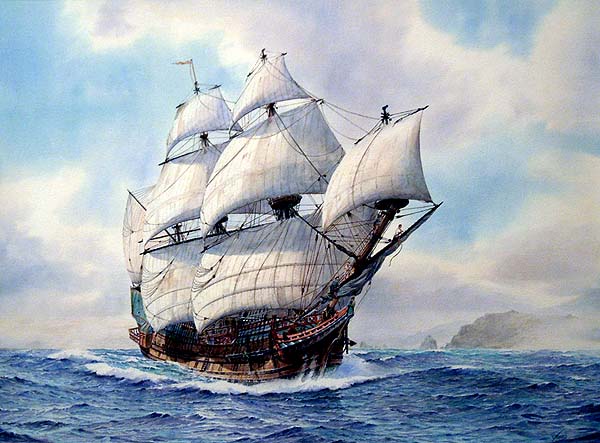
Wrecked off Saipan
The Nuestra Señora de la Concepción was a Spanish galleon operating as part of the lucrative Manila-Acapulco galleon trade when she wrecked off the southern coast of Saipan, an island north of Guam, in what is today the Commonwealth of the Northern Mariana Islands.
The Concepción ran ashore near Aguingan Point, on 20 September 1638. Many of the wreck’s valuable artifacts remain on permanent display in the NMI Museum of History and Culture located in Saipan.
The Concepción was the largest ship of her day with a displacement of 2,000 tons and a length of about 150 feet. In 1636 she sailed from Acapulco in Mexico, to Manila in the Philippines. Two years later, in August 1638, the Concepcion left Manila with some 400 passengers on board, together with an escort ship Ambrosia. In addition to the usual load of silk, ceramics, and other products in her cargo, the Concepcion carried an undetermined number of bales, which belonged to the Captain General (governor) of the Philippines Sebastián Hurtado de Corcuera.
Mutiny onboard
The general-in-command of the Concepción was Juan Francisco Hurtado de Corcuera who was about 22 years old at the time. He was an unskilled navigator and rumors spread that he was assigned his position simply because he was Hurtado de Corcuera’s nephew. Subsequent discontent among Concepción crew members led to a revolt on board, which may have altered the normal route of the ship.
Near the Mariana Islands, completely off course from the return sea route to Mexico (and having lost sight of the Ambrosia), the Concepción was caught in the middle of a storm. Strong winds broke the main mast, leaving the ship without control.
The hull hit against the half-submerged reefs near Aguingan Point, tearing the ship apart. The passengers and crew tried to swim to the coast, but the CHamorus of Saipan naturally distrusted the survivors, whom they met with spears and stones. About 28 Spaniards and some members of the crew managed to survive. In the following years, some of the survivors moved to the nearby island of Rota and others to Guam, where they remained for the rest of their lives.
Some survivors sailed to Philippines
Ten months after the shipwreck a few of the Concepcion’s survivors reached the coast of Samar in the Philippines, after two weeks of arduous navigation in a small canoe, and suffering from hunger, thirst and sun burns under the tropical sun. Eventually one of them met Father Diego Luis de San Vítores in Manila, where he would teach him the rudiments of the CHamoru language. San Vitores later went to the Marianas and established the first permanent Catholic mission.
A 1644 investigation into the wreck found that the incompetence of the general-in-command was partly responsible for the shipwreck. Spanish authorities in the Philippines retrieved part of the cargo and the cannons of the Concepcion 30 years later in 1674. By then, the inhabitants of Saipan had found some of the gold pieces and other metals, and were using them as decorative jewelry and possibly as working tools.
In 1987, a team directed by William M. Mathers, of Pacific Sea Resources (a private company of treasure hunters and archaeologists), started recovery efforts at the remains of the Concepcion. Priceless pieces of gold were found, as well as jars, porcelain wares and other artifacts. Mathers has published a book and several articles describing the recovery efforts.
For further reading
Mathers, William M. “Nuestra Señora de la Concepción.” National Geographic Magazine 178, no. 3 (September 1990): 38-53.
Mathers, William M., and Nancy Shaw. Treasure of the Concepción. Hong Kong: APA Publications Ltd., 1993.
Mathers, William M., Henry S. Parker III, and Kathleen A. Copus, eds. Archaeological Report: The Recovery of the Manila Galleon Nuestra Senora de la Concepción. Sutton: Pacific Sea Resources, 1990.
Schurz, William Lytle. The Manila Galleon. Manila: Historical Conservation Society, 1985.
